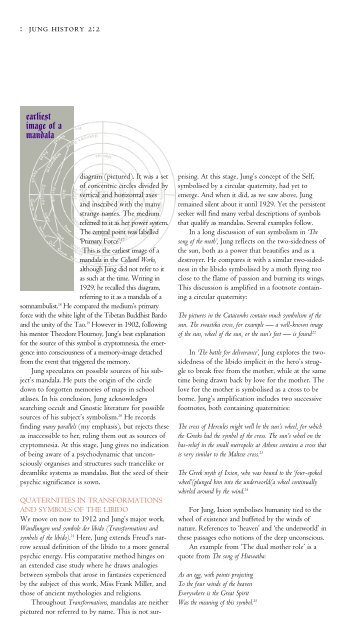a semi-annual publication of the philem n foundation - Philemon ...
a semi-annual publication of the philem n foundation - Philemon ...
a semi-annual publication of the philem n foundation - Philemon ...
You also want an ePaper? Increase the reach of your titles
YUMPU automatically turns print PDFs into web optimized ePapers that Google loves.
: jung history 2:2<br />
earliest<br />
image <strong>of</strong> a<br />
mandala<br />
diagram (pictured). It was a set<br />
<strong>of</strong> concentric circles divided by<br />
vertical and horizontal axes<br />
and inscribed with <strong>the</strong> many<br />
strange names. The medium<br />
referred to it as her power system.<br />
The central point was labelled<br />
‘Primary Force’. 17<br />
This is <strong>the</strong> earliest image <strong>of</strong> a<br />
mandala in <strong>the</strong> Collected Works,<br />
although Jung did not refer to it<br />
as such at <strong>the</strong> time. Writing in<br />
1929, he recalled this diagram,<br />
referring to it as a mandala <strong>of</strong> a<br />
somnambulist. 18 He compared <strong>the</strong> medium’s primary<br />
force with <strong>the</strong> white light <strong>of</strong> <strong>the</strong> Tibetan Buddhist Bardo<br />
and <strong>the</strong> unity <strong>of</strong> <strong>the</strong> Tao. 19 However in 1902, following<br />
his mentor Theodore Flournoy, Jung’s best explanation<br />
for <strong>the</strong> source <strong>of</strong> this symbol is cryptomnesia, <strong>the</strong> emergence<br />
into consciousness <strong>of</strong> a memory-image detached<br />
from <strong>the</strong> event that triggered <strong>the</strong> memory.<br />
Jung speculates on possible sources <strong>of</strong> his subject’s<br />
mandala. He puts <strong>the</strong> origin <strong>of</strong> <strong>the</strong> circle<br />
down to forgotten memories <strong>of</strong> maps in school<br />
atlases. In his conclusion, Jung acknowledges<br />
searching occult and Gnostic literature for possible<br />
sources <strong>of</strong> his subject’s symbolism. 20 He records<br />
finding many parallels (my emphasis), but rejects <strong>the</strong>se<br />
as inaccessible to her, ruling <strong>the</strong>m out as sources <strong>of</strong><br />
cryptomnesia. At this stage, Jung gives no indication<br />
<strong>of</strong> being aware <strong>of</strong> a psychodynamic that unconsciously<br />
organises and structures such trancelike or<br />
dreamlike systems as mandalas. But <strong>the</strong> seed <strong>of</strong> <strong>the</strong>ir<br />
psychic significance is sown.<br />
QUATERNITIES IN TRANSFORMATIONS<br />
AND SYMBOLS OF THE LIBIDO<br />
We move on now to 1912 and Jung’s major work,<br />
Wandlungen und symbole der libido (Transformations and<br />
symbols <strong>of</strong> <strong>the</strong> libido). 21 Here, Jung extends Freud’s narrow<br />
sexual definition <strong>of</strong> <strong>the</strong> libido to a more general<br />
psychic energy. His comparative method hinges on<br />
an extended case study where he draws analogies<br />
between symbols that arose in fantasies experienced<br />
by <strong>the</strong> subject <strong>of</strong> this work, Miss Frank Miller, and<br />
those <strong>of</strong> ancient mythologies and religions.<br />
Throughout Transformations, mandalas are nei<strong>the</strong>r<br />
pictured nor referred to by name. This is not sur-<br />
prising. At this stage, Jung’s concept <strong>of</strong> <strong>the</strong> Self,<br />
symbolised by a circular quaternity, had yet to<br />
emerge. And when it did, as we saw above, Jung<br />
remained silent about it until 1929. Yet <strong>the</strong> persistent<br />
seeker will find many verbal descriptions <strong>of</strong> symbols<br />
that qualify as mandalas. Several examples follow.<br />
In a long discussion <strong>of</strong> sun symbolism in ‘The<br />
song <strong>of</strong> <strong>the</strong> moth’, Jung reflects on <strong>the</strong> two-sidedness <strong>of</strong><br />
<strong>the</strong> sun, both as a power that beautifies and as a<br />
destroyer. He compares it with a similar two-sidedness<br />
in <strong>the</strong> libido symbolised by a moth flying too<br />
close to <strong>the</strong> flame <strong>of</strong> passion and burning its wings.<br />
This discussion is amplified in a footnote containing<br />
a circular quaternity:<br />
The pictures in <strong>the</strong> Catacombs contain much symbolism <strong>of</strong> <strong>the</strong><br />
sun. The swastika cross, for example — a well-known image<br />
<strong>of</strong> <strong>the</strong> sun, wheel <strong>of</strong> <strong>the</strong> sun, or <strong>the</strong> sun’s feet — is found 22<br />
In ‘The battle for deliverance’, Jung explores <strong>the</strong> twosidedness<br />
<strong>of</strong> <strong>the</strong> libido implicit in <strong>the</strong> hero’s struggle<br />
to break free from <strong>the</strong> mo<strong>the</strong>r, while at <strong>the</strong> same<br />
time being drawn back by love for <strong>the</strong> mo<strong>the</strong>r. The<br />
love for <strong>the</strong> mo<strong>the</strong>r is symbolised as a cross to be<br />
borne. Jung’s amplification includes two successive<br />
footnotes, both containing quaternities:<br />
The cross <strong>of</strong> Hercules might well be <strong>the</strong> sun’s wheel, for which<br />
<strong>the</strong> Greeks had <strong>the</strong> symbol <strong>of</strong> <strong>the</strong> cross. The sun’s wheel on <strong>the</strong><br />
bas-relief in <strong>the</strong> small metropolis at A<strong>the</strong>ns contains a cross that<br />
is very similar to <strong>the</strong> Maltese cross. 23<br />
The Greek myth <strong>of</strong> Ixion, who was bound to <strong>the</strong> ‘four-spoked<br />
wheel’(plunged him into <strong>the</strong> underworld(a wheel continually<br />
whirled around by <strong>the</strong> wind. 24<br />
For Jung, Ixion symbolises humanity tied to <strong>the</strong><br />
wheel <strong>of</strong> existence and buffeted by <strong>the</strong> winds <strong>of</strong><br />
nature. References to ‘heaven’ and ‘<strong>the</strong> underworld’ in<br />
<strong>the</strong>se passages echo notions <strong>of</strong> <strong>the</strong> deep unconscious.<br />
An example from ‘The dual mo<strong>the</strong>r role’ is a<br />
quote from The song <strong>of</strong> Hiawatha:<br />
As an egg, with points projecting<br />
To <strong>the</strong> four winds <strong>of</strong> <strong>the</strong> heaven<br />
Everywhere is <strong>the</strong> Great Spirit<br />
Was <strong>the</strong> meaning <strong>of</strong> this symbol. 25


